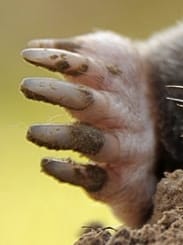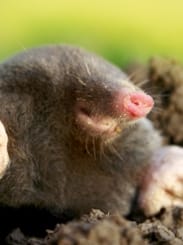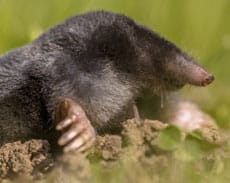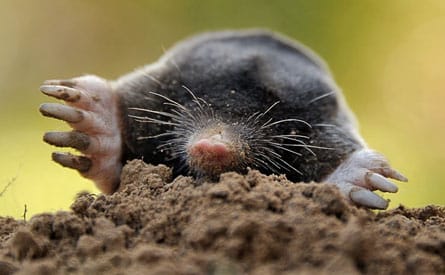

Mole (Talpa Europaea)
Proving date: October 2012
Proving completed by: Misha Norland, Mani Norland & The School of Homeopathy
Common name: Mole
Case: Read a case of Mole
Download: Full proving Mole (Talpa Europaea)
Download: Proving rubrics
About the Mole
Of all the mammals on this Earth, mole is the hardest worker.
For those who normally have boundless energy, enthusiasm and unswerving focus for the task at hand – they have tunnel vision for work without being bothered by any distractions. They easily become annoyed by small talk. They want to get up and get out. Their sense of smell is hyperacute. Eventually they get worn out, and like Nux vomica crave tranquillity; a great sense of fatigue and slowing down overcomes them, along with unconditional acceptance. They switch off, and then they cannot empathise. Then the prospect of having someone getting close feels like an intrusion; an invasion. They feel like saying, 'How dare you! Get away from me!' They feel squeezed in the throat, like a rubber ball being squeezed. They feel as if squeezed into a small place by their responsibilities. It's a rapid downward spiral into a pit that they cannot climb out of. They want to kill people on the street when driving. Same goes for dogs – they want to kill them, stab them, create a bloodbath. They feel other people have been disproportionately aggressive towards them. Feel everyone hates them. Self-loathing. They feel dirty (unclean, need to wash), worthless, abandoned, and miserable. Every situation that comes up makes them question if they have done it right, or if they have wronged another person. As with all mammal remedies, there are maternal issues around birth, breastfeeding, and nurturing. Dreams of being pregnant. Sexual desire is increased, and they enjoy being dominant. Pains generally are needling, cutting, shooting, and cramping.
Mole
The mole, because it has an underground habit, is a creature we know little about, yet its very visible molehills evoke a universally negative response, 'Get rid of that mole!' Until recently, and the advent of video-aided research, scientists have had limited information about the mole due to the impracticalities of studying them in vivo – the chief reason being that they gobble too much food to allow for a viable period of observation in captivity. They gather and guzzle in an almost non-stop cycle to fuel their incessant labour of tunnelling. They can excavate 25 m a day, and continually tunnel to renovate and extend their home and larder. They are by far the most industrious of mammals! They work in a shift pattern of 4 hours at a stretch; during periods of rest, moles will either sleep or consume the food needed to keep going for the next work stint. The mole’s upper body and strong spade-like front limbs are perfectly designed for moving heavy soil and when digging, a specialised bone structure allows the mole to project a lateral force equivalent to 32 times its body weight.
The mole is a solitary creature, that will fight to the death defending its territory except when female moles are on heat, and the urge for a partner overcomes territorial issues. The mole is the only known mammal in which the female has been found to possess features of both female and male reproductive organs. The mole produces very high levels of testosterone, which may account for their aggressive nature, and look-alike external genitalia that are of similar size. High testosterone levels promote bone growth that link to the evolution and development of a sixth digit that is in fact, a modified wrist bone.
The gestation period for female moles is 4–6 weeks and they will give birth to 3–6 young each year. After just a few months of growth, adolescent moles will be totally self-sufficient and will leave the adult home to find residence elsewhere, taking over unoccupied tunnel systems or digging their own. It is during this crucial time that they venture above ground and become vulnerable to predators such as stoats, owls, foxes, and badgers. Moles have been known to live to the age of 6 years provided they are not picked off by predators or killed by humans, and most live for 4 years.
The Latin meaning of mole derives from ‘massive heap’ or ‘large mass’. This clearly refer to their excavations, the mole heap, and not the size of their body. It is typically a mere 12 cm long. Its fur is black and velvety allowing the mole to move both forwards and backwards through its underground passageways with ease. The mole has poor eyesight, but can differentiate between light and dark. Its other senses are extremely heightened to compensate for this, for example, the mole has ultra-sensitive whiskers on its pointed pink snout, a highly-developed sense of smell, and is able to sense the slightest of underground vibrations. This characteristic allows gardeners to discourage moles from an area by burying vibrasonic equipment. Moles can tolerate higher CO2 levels than other mammals, permitting them to survive underground for extended periods. They have modified red blood cells with augmented haemoglobin.
The mole’s appetite is colossal; it needs to consume 70–100% of its body weight per day. Earthworms are the main source of food, especially during the Winter months, but it will eat all manner of insect larvae, and grubs, dependent on availability. To ensure that it has a sufficiently fresh supply of food, the mole will bite the head of a captured worm, rendering it immobile while still alive.
Moles are most commonly found in fertile soil with adequate drainage, however, they are good swimmers and can escape from flooding. The mole favours deciduous woodland as its habitat, and grassland, where its burrowing habit and molehill production, may create conflict with farmers, and gardeners. Many people are unaware that molehills are created only once, while the creatures establish or extend their home. An adult mole will only come to the surface of its underground habitat to collect materials for a nest. During this time a much larger molehill (called a fortress) will be created under which the mole will rear its young. The deepest tunnels are used during times of extreme weather, for example cold or drought. If left to their own devices in a well-established tunnel system, most people would scarcely notice the many moles residing underneath their land.
Mythology
Magical properties: Pliny the Elder in Naturalis Historia (77–9 ad) wrote, ‘Of all the animals the magi hold moles in highest regard ... they give credence to no other entrails as much, and they credit no other creature with more supernatural properties, so that if someone should swallow the heart of a mole, fresh and still palpating, they promise the power of divination and foreknowledge of future events. By removing the tooth of a living mole and binding it to the person, they claim that toothache can be cured.’ In Britain, moles were associated with witchcraft but by the late 18th century, perceptions had changed and it was believed the healing power of a dying mole would be transferred to an individual who held it.
North Americans: In North American mythology, burrowing animals were linked to the underworld and its dark associations. The story of how the mole came to live underground is told in a Cherokee folktale, Why the Mole Lives Underground. Here the mole is depicted as a shifty, untrustworthy character who puts a deceitful plan into action, and when confronted about the consequences of his actions, retreats to his underground sanctuary in fear of punishment. The Zuni tribes believe the mole is the Hunter god, looking after the crops, being guardian of Inner Earth.
History
Legal protection: At present, the mole has no legal protection in the UK. They are not protected by conservation legislation, only having basic protection from cruelty under the Wild Mammals Protection Act 1996. Moles are prone to being poisoned and trapped, an exercise that is widely practised even though in the long run, it is ineffective. New moles quickly move into old tunnels!
Literature: The depiction of Kenneth Grahame’s industrious, initially solitary yet loveable, character fits with what we know about this creature’s behaviour, and habits. In the opening chapter we see mole frantically Spring-cleaning his house, mention is made of his aching back and arms, which bear the brunt of most of the mole’s activities. An air of ‘discontent and longing’ is hinted at throughout the novel. Mole’s journey of discovery lies in his realisation that there is a whole other world above his dark, underground sanctuary.
Chinese calendar: According to Chinese tradition, moles are born during the Chinese zodiac’s year of the sheep. It is believed that people born at this time are generally hardworking and loyal, but have a tendency to take things to heart, easily becoming offended. They will put on a front to hide this but are plagued by feelings of self-doubt. They work best when striving towards a goal or purpose, they want to ‘get it right’ all of the time. They are extremely strong both physically and mentally, often more so than anticipated by those around them.
Espionage: Within the realm of espionage, the mole is somebody who works for an organisation whilst continually feeding information to a rival from within, posing as an ally to the original establishment. By his or her very nature someone who is to succeed as a mole must be deceitful and cunning. They must be well practised in the deception of others in order to gain their friendship and trust. The fact that the mole is acting mainly alone and does not care for allies can be linked to its animal counterpart, in so far as the animal works alone and has been observed to be fiercely territorial towards others of its kind.
The proving
The mole came to us gratis, up out of Misha's lawn, and was captured thanks to his cat’s alacrity. The moles paws were chopped off and pickled in a small bottle containing absolute alcohol. There they remained in the dark and the cool for some years awaiting the day of the proving.
General themes emerged in the proving that reflected the uniqueness of the mole family, these being their industrious nature with constant activity, huge energy, and relentless pursuit of territory. A steady determined energy with clear-headedness enabled the provers to keep going long into the evening. Unsurprisingly, given that males and females look alike until the Spring breeding season, when females become recognisable and males extend tunnels in search of a mate, pregnancy and sexual activity featured in the proving. There were dreams of getting somewhere or doing something that had to be done, and there was even a dream about a tunnel. These concepts, combined with testosterone levels in both sexes, are the making of a highly industrious personality, like Nux vomica. Unlike the typical Nux vomica though, most provers felt calm in relation to things they needed to do that previously might have riled them. Action was with a Zen-like clarity and desire to work all day until the job was complete rather than a ‘must do it’ driven imperative.
From the group’s perspective, equanimity was an important theme, with calmness in situations where calmness would not have been a normal response; also being carefree, with joyful freedom, giddiness, and light-heartedness that was described by one prover as a slightly ‘tipsy’ feeling. There was also tiredness, and detachment from the rest of the World, as if living in one’s own bubble; a great sense of fatigue and a slowing down, along with acceptance of change, and unexpected events that would otherwise have been bothersome. There were issues with communication and provers experienced difficulty in writing words and sentences, and also losing their voice. Carelessness came with a difficulty of thinking and making decisions. Things just happened. Darkness was another feature of the proving, accentuating the symptoms of tiredness, and lack of energy. There was painlessness (menstruation) and disconnection that presented itself in different ways relating to flow, such as, electrical powercuts, a dream about not being able to switch off the television, communication that didn't happen with a supervisor on some days, etc. Initially there was compassion and concern for people who were ill-treated, but this progressed into a lack of empathy and morbid fascination at the sight of road kill or other dead animals. A theme of destructive violence emerged, and thoughts about decapitation without aggression. There was swearing without overt anger and guilty disgust with a feeling that 'everyone hates me'. Fingernails became soft and bendy breaking and tearing easily. The sense of smell was amplified – scent is important in finding a mate – to such an extent that one prover demanded to have the bathroom flooring replaced due to a urine smell that no one else could detect. A couple of supervisors lost their sense of smell completely and one also lost their sense of taste. The mole's short-sightedness featured with many eye symptoms developing during the proving and also the polar opposite, with imagery of being above ground in the light, being joyful and bright.
Download: Full proving Mole (Talpa Europaea)
Download: Proving rubrics

Destructive - Decapitation - Tunnels - Industrious - Pregnancy - Guilty disgust - Flow - Equanimity - Joyful freedom
Proving Themes
Kingdom: Animalia
Phylum: Chordata
Class: Mammalia
Order: Soricomorpha
Family: Talpidae
Genus: Talpa
Species: Talpa Europaea
Kingdom Taxonomy
The mole produces very high levels of testosterone, which may account for their aggressive nature and look-alike external features. High testosterone levels promote bone growth that link to the evolution and development of a sixth digit that is in fact a modified wrist bone.

.jpg)
